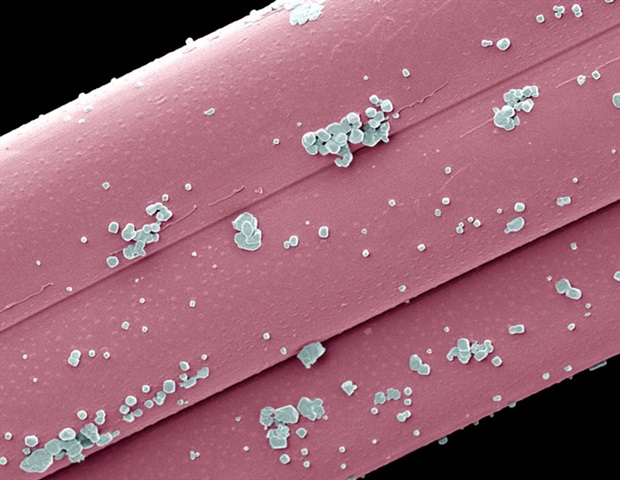A newly developed “GPS nanoparticle” injected intravenously can home in on cancer cells to deliver a genetic punch to the protein implicated in tumor growth and spread, according to researchers from Penn State. They tested their approach in human cell lines and in mice to effectively knock down a cancer-causing gene, reporting that the technique may potentially offer a more precise and effective treatment for notoriously hard-to-treat basal-like breast cancers.
They published their work today (March 11) in ACS Nano. They also filed a provisional application to patent the technology described in this study.
We developed a GPS nanoparticle that can find the site where it is needed. Once there -; and only there -; it can deliver gene editing proteins to prevent the cancer cells from spreading. It was a difficult task, but we showed that the system works for basal-like breast cancers.”
Dipanjan Pan, corresponding author, the Dorothy Foehr Huck & J. Lloyd Huck Chair Professor in Nanomedicine and professor of nuclear engineering and of materials science and engineering at Penn State
Similar to triple-negative breast cancers, basal-like breast cancers may be less prevalent than other breast cancers, but they can be far more challenging to treat, largely because they lack the three therapeutic targets found in other breast cancers. They also tend to be aggressive, quickly growing tumors and shedding cells that spread elsewhere in the body. Those cells can seed additional tumors, a process called metastasis.
“Metastasis is a huge challenge, especially with cancers like triple-negative and basal-like breast cancers,” Pan said. “The cancer can be hard to detect and does not show up during a routine mammogram, and it primarily affects the younger or African American population who may not be receiving preventative care yet. The outcome can be very, very poor, so there’s a clear unmet clinical need for more effective treatments when the cancer isn’t caught early enough.”
The team fabricated a Trojan horse nanoparticle, disguising it with specially designed fatty molecules that look like naturally occurring lipids and packing it full of CRISPR-Cas9 molecules. These molecules can target the genetic material of a cell, identify a particular gene and knock it down, or render it ineffective. In this case, the system targeted human forkhead box c1 (FOXC1), which is involved in instigating metastasis.
Pan described the designer lipids as “zwitterionic,” meaning they have near neutral charge on the nanoparticle’s shell. This prevents the body’s immune system from attacking the nanoparticle -; because it is disguised as a non-threatening, normal molecule -; and can help release the payload, but only when the lipids recognize the low pH environment of the cancer cell. To ensure the lipids would only activate at that low pH, the researchers designed them to shift their charges to positive once they enter the more acidic tumor microenvironment, triggering the payload release.
But the body is a vast place, so how could the researchers ensure the CRISPR-Cas9 payload made it to the correct target? To ensure that the nanoparticle would bind to the right cells, they attached an epithelial cell adhesion molecule (EpCAM), which is known to attach to basal-like breast cancer cells.
“No one has ever attempted to target a basal-like breast like cancer cell with context-responsive delivery system that can genetically knockdown the gene of interest,” Pan said. “We’re the first to show that it can be done.”
Others have developed viral delivery systems, hijacking a virus particle to carry treatment to the cells, and non-viral delivery systems, using nanoparticles. The difference, Pan said, for his team’s approach is the surface lipid designed to respond only in the target environment, which reduces the potential for off-target delivery and harm to healthy cells. Also, he added, since the body doesn’t consider the lipids to be a threat, there’s less chance for an immune response, which they validated in their experiments.
The team first tested the approach in human triple-negative breast cancer cells, validating that the nanoparticle would deploy the CRISPR/Cas9 system in the correct environment. They confirmed that the nanoparticle could find its way to a tumor in a mouse model, deploy the system and successfully knock down FOXC1.
Next, Pan said, the researchers plan to continue testing the nanoparticle platform with the eventual goal of applying it clinically in humans.
“We are also exploring how else we might apply the platform technology,” Pan said. “We can customize the molecules on the surface, the payload it carries, and use it to encourage healing in other areas. There’s a lot of potential with this platform.”
First author Parikshit Moitra, was a research assistant professor of nuclear engineering in Pan’s laboratory at Penn State at the time of the study and is now an assistant professor at the Indian Institute of Science Education and Research at Berhampur; David Skrodzki, Matthew Molinaro, Nivetha Gunaseelan, all doctoral students at Penn State; Dinabandhu Sar, University of Illinois, Urbana-Champaign; Teresa Aditya, postdoctoral researcher in nuclear engineering at Penn State; Dipendra Dahal and Priyanka Ray, both postdoctoral researchers in Pan’s laboratory at his previous institution of the University of Maryland Baltimore.
Source:
Journal reference:
Moitra, P., et al. (2024) Context-Responsive Nanoparticle Derived from Synthetic Zwitterionic Ionizable Phospholipids in Targeted CRISPR/Cas9 Therapy for Basal-like Breast Cancer. ACS Nano. doi.org/10.1021/acsnano.4c01400.








